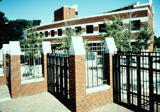 Brick is the oldest manufactured building material. The earliest brick, made from mud (sometimes with added straw), was
invented almost 10,000 years ago. Clay brick started to appear about 5,000 years ago, when builders borrowed pottery manufacturing techniques to improve its strength and durability. From some of the oldest known structures to modern
buildings, clay brick has a history of providing shelter that is durable, comfortable, safe, and attractive.
Brick is the oldest manufactured building material. The earliest brick, made from mud (sometimes with added straw), was
invented almost 10,000 years ago. Clay brick started to appear about 5,000 years ago, when builders borrowed pottery manufacturing techniques to improve its strength and durability. From some of the oldest known structures to modern
buildings, clay brick has a history of providing shelter that is durable, comfortable, safe, and attractive.
Primary raw materials for modern clay bricks include surface clays, fire clays, shales or combinations of these. Units are formed by extrusion, molding or dry-pressing and are fired in a kiln at high temperatures to produce units with a wide range of colors, textures, sizes and physical properties. Clay and shale masonry units are most frequently selected as a construction material for
their aesthetics and long-term performance.
While brick and structural clay tile are both visually appealing and durable, they are also well-suited for many structural applications. This is primarily due to their variety of sizes and very high compressive strength.
Concrete brick is a very effective way to make a strong first impression. When people walk up or drive by a home with concrete brick, second glances are common reactions.
Concrete brick has more benefits than its striking visual qualities. They deaden exterior noise, providing a buffer from traffic noise, airplanes flying overhead and other various disruptions. Fire protection is another benefit as is reduced maintenance. Finally, concrete brick walls can improve the thermal mass qualities of exterior walls, thus reducing energy bills.
This brick has a molded bark texture face.
Bricks are also available with a rough estate texture face.
Design
The requirements for good performance from a concrete brick wall include:
- A foundation which will handle the weight of the brick veneer
- A well-braced back-up wall which will handle the veneer load
- Proper attachment to the back-up wall
- Proper design and detailing of expansion joints, flashing, and drainage
- Proper use of materials
- Good workmanship during construction
Styles
Concrete brick is manufactured in various colors and patterns. The type of finish is even an option; smooth, sandblasted, stone pattern, etc. The concrete used to produce the bricks can be anything from regular aggregate concrete to various mixtures of lightweight aggregates. They are usually colored with iron oxide pigment at the surface, or the pigment is present throughout the mixture.
As shown by the pictures above, brick come in many styles. This can help blend a house in with its natural surroundings or neighboring houses.
As shown by the pictures above, brick come in many styles. This can help blend a house in with its natural surroundings or neighboring houses.
Mortarless Brick
A new exterior wall system uses concrete bricks cast in special shapes that require no mortar and can be installed by anyone with basic carpentry skills. The system provides homeowners with the effective look of real brick exteriors.
The dimensions and appearance of the brick faces are similar to traditional split-faced bricks, and like bricks used for conventional veneer walls, they are installed in staggered rows. Hidden from view is the unusual shape of the cast block, which allows shingle-like overlapping. Because the system does not require footings or mortar, it can be used on new or existing buildings. Installers stack the blocks in rows and screw them to vertical furring strips attached to the wall sheathing. The furring strips provide a positive connection and create an air space, allowing the veneer surface to breath and providing drainage for any moisture that may penetrate. Thermal insulation characteristics are about the same as common face brick (R-0.11) and each unit weighs just over four pounds. Because of the interlocking shape of the materials, the system requires no mortar and can be installed by a contractor, handyman or homeowner with basic woodworking and layout skills. Like traditional split-face brick, the system is strong and durable and will not dent, chip or fade in color.
Information courtesy of Home Innovation Research Labs.
Troubleshooting
Removing grout residue with acidic cleaners is risky for concrete surfaces. Do not use a sealer as a grout barrier. Prevent grout smears, surface scratching and keep grout residue out of any surface texture characteristics by coating before grouting.
Efflorescence (subsurface originating white powdery stains) and scuffing can occur. However, this is easily cleaned. If it is a concern, choose a penetrating sealer.
Colors can fade. It's the iron oxide pigments used in concrete products that do not fade. The appearance of fading is actually from light efflorescence and can be stopped by sealing with the appropriate sealer.
All concrete products are subject to damage from acids. However, the appropriate sealer helps prevents this.
Information courtesy of Aldon Chemical. Additional information about brick may be found at The Brick Industry Association web site.